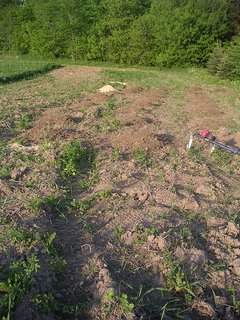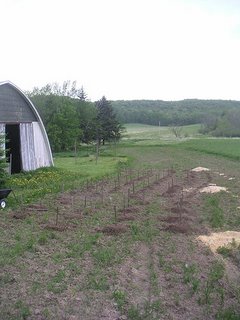There is a ton of information on the web already about the Three Sisters garden, but since I want to start keeping a better record of what we're up to here, I thought I'd add my own description.The "Three Sisters" consist of Corn, Beans and Squash. Native Americans (I'm not sure which particular groups) would plant these three crops together because of their complimentary nutritional value and how each member of the guild benefits the others. The beans climb the corn and convert nitrogen from the air into plant food. The squash acts as a living mulch, keeping the soil moist and weeds in checkspan>
Our good neighbor Bill disked about an acre of our field for us, on half of which we planted trees. It will eventually turn back into hay, but I thought it would be good to make use of its temporary receptivity and plant some food there. I chose the Three Sisters because of the above benefits and that it is a relatively low maintenance form of gardening. The field is located just far enough from the house that we wouldn't want to be walking back and forth that often.
After doing a little research, I discovered that there are as many ways of making this garden as there are people telling you how to do it. I took a little from each, but relied most heavily on Toby Hemenway's book, Gaia's Garden: A Guide to Home-Scale Permaculture, and also this article from Mother Earth News. Basically I made 56 mounds (4 mounds deep and 14 long) on the South side of the field. I would guess that it takes up about 1/10 of an acre, but I could be way off. The mounds are about a foot high, 20 inches wide, and 5 feet away from each other in all directions. I tilled up the soil with some added manure and compost and then raked it into a flat-topped mound. After finishing the mounds they looked like this: I put the corn kernels in a bowl of water and let them soak overnight. The next day (with some help from my lovely wife) I planted four kernels in the center of each mound and set a stake in the middle to mark where they are. (As we discovered last year, the weeds can grow up pretty quickly and hide the mounds.) I also planted a variety of sunflowers around the edges of the garden to give it some shelter and added beauty. Here is what it looks like at this point:
I put the corn kernels in a bowl of water and let them soak overnight. The next day (with some help from my lovely wife) I planted four kernels in the center of each mound and set a stake in the middle to mark where they are. (As we discovered last year, the weeds can grow up pretty quickly and hide the mounds.) I also planted a variety of sunflowers around the edges of the garden to give it some shelter and added beauty. Here is what it looks like at this point: 
After a week or so when the corn is about 4 inches tall I'll plant the beans on the edges of the mounds. A week after that I'll plant the squash. I'd say the whole project has taken about four hours thus far, and there is really not much more to do. There will be some minimal weeding in the beginning, but after a few weeks the squash should take care of that part. If it's really dry for a stretch we'll probably have to water it, but again, the squash will keep the ground moist throughout shorter dry spells.
We are working towards being able to subsist on what we grow, and I see this garden as a significant step in this process. Corn, beans and squash all store well, and are all good for you as well. The corn and beans that aren't eaten as they ripen can be left to dry where they stand. The squash should keep for quite a while if kept in a root cellar. I'll try to update as things progress. If anyone has suggestions or comments I'd love to hear them.
Wednesday, May 24, 2006
The Three Sisters
Subscribe to:
Post Comments (Atom)
6 comments:
Thank you for the vegeblog! I love reading about what y'all are planting/growing.
Q: What kind of squash are y'all raising? (Yellow? Zucchini? Other?)
Our great-grandmother seemed to always have a big canning jar full of cooked yellow squash in her round-cornered fridge. She made some fresh every few days, cooking it with white onion and salt and pepper and the tiniest bit of sugar. It was wonderful.
She lived into her mid-90's. We think those vegetables had a lot to do with it.
Wishing you squash and beans and corn at the tables of your grandchildren,
Kath
Thanks for your comment.
We will probably grow a variety of different squashes and pumpkins. For the three sisters garden we'll plant varieties that spread out all over to cover the ground around the corn/bean mounds. We've already started some Heirloom varieties that are presently in the coldframe waiting to go in the ground. I'm not sure how much sqashes cross-pollinate, but we'd like to save our own seed for next year.
Thanks for the recipe as well. We'll need a lot of those if we get the harvest we're hoping for!
I second Chris's thanks for the recipe and we welcome any others you all may have...be they for rhubarb, squash, tomatoes, radish, parsnip, corn - you name it. We will have loads of produce to store/can/freeze and look forward to using new and recommended ways to prepare them!
Becca
Multiple varieties. This is going to be fun!
Corn recipes - do y'all already sautee kernels of corn with diced green and red bell peppers and white onion? That's one of our family favorites.
Do y'all can chow chow or Piccalilli [http://en.wikipedia.org/wiki/Piccalilli] to go with the beans? We make bean soup by smooshing or pureeing cooked pinto beans to thicken the soup, adding celery salt and black pepper and a drizzle of olive oil, then topping with a dollop of chow chow or mango peach salsa, and perhaps sour cream. Or you can grate cheese into it, etc. Or top with any sort of salad makings - shredded lettuce, tomato, onion, celery, red or yellow bell pepper, etc.
We freeze plain seasoned bean soup and it's really handy for when you want a warm and filling supper. Add cornbread or rolls or any sort of bread.
[Feeling silly, bringing these coals to Newcastle. Ya'll are the best cooks.]
Kath
There are four species of squash: C. maxima (large winter squashes), C. peop (pumpkins, and summer squashes), C. moschata (butternut), and C. mixta (cushaw varieties. These four species can be planted together and will not cross-polinate. However, cross-pollination does occur within these species and the resulting seeds will produce unpredictable varieties. So we can plant four different kinds of squashes in the three sisters garden and not worry about cross pollination.
Squashes within the same species need to be planted at least 1/4 mile away to avoid cross-pollination. This leads to an interesting question: does it really matter if things cross-pollinate and "weird" varieies are produced? Jay and I have talked about planting apple seeds around the farm just for this purpose.
Curcurbits are (like apples) heterozygous (which you know already). In my (severely limited) experience, the fruit of curcurbit "hybrids" is beautiful though bitter to the point of inedibility. But, if you pay close attention to male flowers and female flowers, you can manually fertilize (then tie up to exclude other pollen) to make sure mom and pop create a certain sort of inbreed (which is what you want for tasty zuchinni, yellow summer squash, melons, varieties of winter squash, cucumbers of many sorts, et cetera). Sounds like a lot of work to me. For much more accurate information, see Seed to Seed by Susan Ashworth. -matthew
Post a Comment